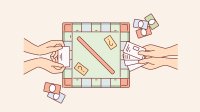Game-Based Learning in Civics
Teachers can use games, both physical and digital, to help students build a foundation for understanding complex content.
Your content has been saved!
Go to My Saved Content.Civics can incite a lot of emotions. Before diving into content, it can be worthwhile to help students understand the skills they might need to navigate complex topics, especially those that can feel abstract or irrelevant.
For instance, in the lower grades, students might not yet be able to grasp the concept of a citizen or agree on what that means. At the secondary level, topics like the Electoral College, the costs of elections, super PACs, or gerrymandering can cause students to be upset (and that’s OK). It’s not enough to present students with civics content—we must ensure that they have the skills they need to engage with the material in an effective way.
This is where it gets tricky. Often, when we think about the skills a citizen needs, we might focus on media literacy, problem-solving, collaboration, being able to express opinions, debate, negotiate, resolve conflicts, etc. While these are a logical starting point, sometimes we might need to go even more basic.
SEL skills in civics
Activities that foster social and emotional learning (SEL) can offer a foundation to help students hone abilities like self-awareness, interpersonal skills, and good decision-making. These act as stepping stones to help students grow their citizenship skills and ensure that they can have the meaningful conversations they need to engage with civics content.
How do we help students develop these skills while also engaging in the civics curriculum? Games, physical and digital, provide a unique opportunity to help students hone skills while providing an immersive way to experience content.
During the elementary years, concepts like respecting others or fairness might come up in relevance to citizenship. Instead of talking about them, let students experience these concepts. Games can help facilitate that experience for students through play, and in the process, they exercise skills like self-regulation, reasoning, and tolerance (e.g., Chutes and Ladders). With older students, imagine trying to engage them in the complexity of the government. Games like Risk or Monopoly can help make seemingly big, abstract topics more tangible so that students can better digest what they’re learning while practicing skills like good decision-making.
Of course, many traditional board games might not exactly match our content or help us to ensure that students are practicing the skills we’d like to see them develop. This is where game creation can add a lot of value to our pedagogy and practice. It’s often much simpler than we might imagine and a great pathway to helping students engage in both content and skill-building.
Creating physical games
There are reasons why teachers might not rush off to make physical games. Time, resources, and confidence are just a few. To help you get started, here are some ideas to think about:
Time. As with any lesson plan or project, there’s a bit of time that goes into the development. The thought of creating a new game can be daunting, but much like any initial lesson plan, it involves trial and error. Once it’s created, you’ll have it for years to come and can share it with others. It’s worth the investment.
Keep it simple. Too often, the thinking is that you need to create a professional-looking game—you don’t. Games come in all forms. Dice, cards, spinners, and boards are just a few of the tools you can use in game creation. You can recycle or upcycle old materials to make a game. For instance, buttons make great game pieces, and cardboard boxes provide the perfect base for your board game or spinner. You can also make “print and plays” available on Civics Through Play. Use Canva to design a directions page or create basic resources like playing cards.
Basics of game design. In order to make a great game, consider these basic elements:
- Story arc. Use classroom content to help determine the roles of players and how they immerse themselves in the game.
- Goals. What’s the purpose of the game (usually, how you win), and what objectives do players need to achieve?
- Decisions. What kinds of decisions will players need to make and/or what actions will they need to take to navigate the game?
- Debrief. How can you help students reflect on their gameplay to realize the skills they’ve exercised or knowledge they’ve gained?
Games as assessments
You don’t necessarily have to make the game yourself. Turn game creation into a STEM activity that also assesses student knowledge. Students demonstrate mastery of the content through their story arc while developing skills as they work through their game design.
For instance, in the younger years, they could make a game around community helpers—those who live and work in their neighborhood. Some kids might design a sort of truth or dare; some might create something that looks like Candy Land. For older grades, they might design a game around discussing current events or voter turnout.
Digital options
If you’re not keen to create your own game, you could also just see what’s out there. Digital games abound in the civics space. Simply searching on “games on [insert topic]” can highlight simulated experiences for your students to try. For instance, iCivics has a simulation for students to understand what it might be like to run for president. The New York Times has a game to help students explore the concept of gerrymandering.
For more-involved options, games like Statecraft provide a completely immersive way for students to learn the ins and outs of government.
Don’t underestimate the power of games—play—in creating meaningful learning experiences. It’s an extraordinary way for students to be immersed in content while building relevant skills. It’s easy to get started, and anyone can learn how to make a great game.
